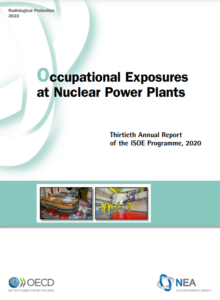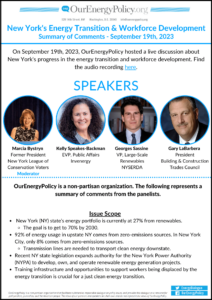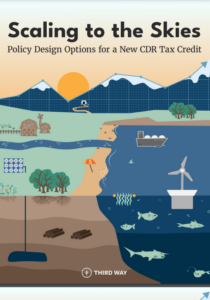The OurEnergyLibrary aggregates and indexes publicly available fact sheets, journal articles, reports, studies, and other publications on U.S. energy topics. It is updated every week to include the most recent energy resources from academia, government, industry, non-profits, think tanks, and trade associations. Suggest a resource by emailing us at info@ourenergypolicy.org.
Resource Library
The hype around clean hydrogen as a decarbonization tool overlooks the fact that all hydrogen significantly increases global warming if it leaks into the atmosphere, and its use with natural gas does not substantively reduce greenhouse gas emissions. This two-page fact sheet outlines the potential global warming impacts of increased hydrogen use.…
View Full ResourceThe United States offshore wind industry looked set for increased momentum in 2023 as President Biden’s administration pushed for 30 gigawatts (GW) of capacity by 2030. Yet permitting delays and inflation have stymied the industry’s short term outlook, with developers seeking new power purchase (PPA) terms on at least 10 East Coast projects by mid-September.
By October, the crisis had forced Massachusetts, Rhode Island, and Connecticut to join forces for offshore wind procurement, aiming to reduce construction costs in the face of PPA cancellations from developers Avangrid, Shell, and Ocean Winds.
Despite these setbacks, U.S. offshore wind remains a $70 …
View Full ResourceThe report provides a guiding framework for planning and implementing solar-plus-storage projects, while leveraging private investments. The report’s framework outlines four-phases covering the identification and planning of a project, selection, and adaptation of a business model from three pre-set configurations, and finally utilizing complementary PPA template resources in a competitive procurement process.
The report aims to streamline adoption and deployment of IPP-owned solar-plus-storage hybrid generation projects, especially in countries where reliance on fuel-based thermal generation is deepening their vulnerability and deficits, accelerating a much-needed transition.…
View Full ResourceThis study investigates the impact of pollen as a PV soiling agent. The performance data of five utility-scale PV plants in North Carolina was collected and analyzed using two soiling extraction methods. Satellite and environmental data, including pollen counts, cropland, and vegetation, was also collected and analyzed to identify impacts to soiling losses.
During the spring peak pollen season, performance losses of 15% were observed at all five sites. Partial performance recoveries following the pollen season were slow, with lack of correlation with rainfall. This means that the statistical soiling estimation methods that assume abrupt performance recovery from rain are …
Information System on Occupational Exposure (ISOE) is jointly sponsored by the Nuclear Energy Agency (NEA) and the International Atomic Energy Agency (IAEA). Since 1992, ISOE has provided a forum for radiological protection professionals from nuclear licensees and national regulatory authorities worldwide to share dose reduction information and operational experience aiming to improve the optimisation of radiological protection at nuclear power plants.
As of 31 December 2020, the ISOE programme included 76 participating nuclear licensees (with 342 operating units, 11 units under construction and/or commissioning, and 76 shut down units) and 27 regulatory authorities in 31 countries. The ISOE database gathers …
View Full ResourceRead this event summary for the key takeaways from our expert panel luncheon discussion about New York’s progress in the energy transition and workforce development.…
View Full ResourceIt is likely that within the next 5 years the world will reach 1.5 degrees of warming, exceeding the target cap on warming agreed to in the Paris Climate Accords. The effects of exceeding this target are dire and cannot be understated, but it is notable that the Intergovernmental Panel on Climate Change (IPCC) envisions scenarios where it is possible to return to a level of warming below 1.5 degrees and avoid breaching the 2.0-degree threshold. Those scenarios are achieved by rapidly pursuing decarbonization while simultaneously deploying Carbon Dioxide Removal (CDR). It is projected that to achieve that level of …
View Full ResourceAs carbon removal transitions from a small area of research to an industry with hundreds of new projects breaking ground, it is essential it grows in ways that are good for people as well as the planet, with justice and responsibility in mind.
This white paper is intended to be a resource for both carbon removal companies as well as project reviewers and funders who are committed to ensuring the industry grows responsibly and prioritizes communities. It also introduces and provides context around the XPRIZE Carbon Removal Finalist Application submission questions related to responsible deployment and environmental justice that is …
View Full ResourceAmerica’s electric cooperatives (co-ops) are crucial engines of economic development both nationally and at home in their local communities. In addition to providing safe, affordable, and reliable electricity to their consumer-members, co-ops create benefits that extend beyond the electric sector. As locally-engaged member-owned electric utilities, co-ops conduct economic activity through the generation, transmission, and distribution of electricity, including investments in new capital, operating and maintenance expenses, and disbursement of capital credits. These activities not only impact the industries in which they directly occur, but also drive economic activity across multiple sectors, creating value for local, statewide, and national economies.
The …
View Full ResourceThe challenges facing the Nation’s energy system have substantially shifted in the last one hundred years and will continue to evolve. Yet, today’s grid cannot adequately support 21st century challenges —including the integration of new clean energy sources and growing transportation and building electrification — while remaining resilient in the face of extreme weather exacerbated by climate change. The power grid is the backbone of the nation’s electricity system, and it must adapt to maintain reliability and resiliency.
The National Transmission Needs Study (Needs Study) is an assessment of existing data and current and near-term future transmission needs through 2040. …
View Full Resource








